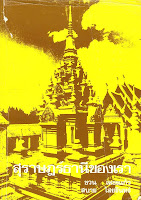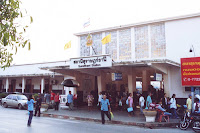As my Thai is still not good, I just browsed through the book so far and tried my luck on reading only for the part I am most interested - the history of the province, how the Mueang in the area were changed into the single province with its districts. To come to my point, the book contains a list of 11 districts in the province, but only dated as being during the reign of King Rama VI, that means before 1910. It is thus an older list than the one I have found in the Royal Gazette, which dates from 1917.
So below is the list of these 11 districts, together with their names in 1917 and today.
- เมือง (Mueang), in 1917 renamed บ้านดอน (Ban Don) was renamed to Mueang and later into Mueang Surat Thani
- พุมเรียง (Phumriang), in 1917 named เมืองไชยา (Mueang Chaiya) in 1917, and simply Chiaya today. This was the old center of the province at the coastal village Phum Riang.
- เกาะ (Ko) - this should be the one named เกาะสมุย (Ko Samui) in 1917. Maybe this old named, which simply means island, was chosen because the district covered all the islands off the coast.
- คีรีรัฐนิคม (Khiri Rat Nikhom), in 1917 renamed to ท่าขนอน (Tha Khanon) and today it has its historical name again.
- พุมดวง (Phum Duang), renamed to ท่าโรงช้าง (Tha Rong Chang) in 1917. Was included into Phunphin later.
- พุนพิน (Phunphin), same-named as today and in 1917, yet it was named ท่าข้าม (Tha Kham) in the meantime as well.
- กาญจนดิษฐ์ (Kanchanadit), same-named in 1917 and today.
- ประสงค์ (Prasong), downgraded to a minor district which is missing in the 1917 list though it was abolished in 1919. It was recreated as ท่าชนะ (Tha Chana) in 1948.
- พระแสง (Phrasaeng), same in 1917 and today.
- ลำพูน (Lamphun), in 1917 renamed to บ้านนา (Ban Na) and now named Ban Na San.
- พนม (Phanom), same as in 1917 and today, except that it was downgraded to a minor district 1910 till 1971.
The book continues to list 12 districts in the 6th reign - the changes to the one above are Mueang named Chaiya, Ko named Ko Samui, Prasaeng, Phanom and the new Tha Chana as minor districts. Then it lists 10 districts in 1937 (abolish of Phum Duang and Prasong), 11 in 1948 (creation of Tha Chana), and finally the 19 as of 1994, which is the same as today.
While for most of the district changes I have found the corresponding announcements in the Royal Gazette, especially the name changes and the abolishing of Phum Duang I cannot date yet.












